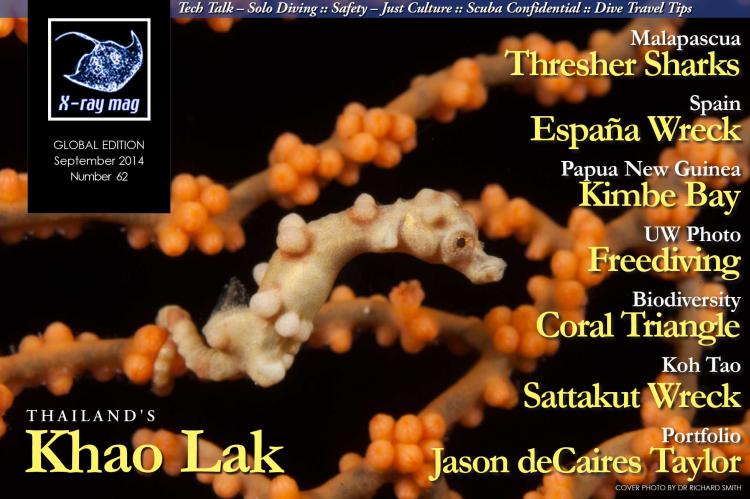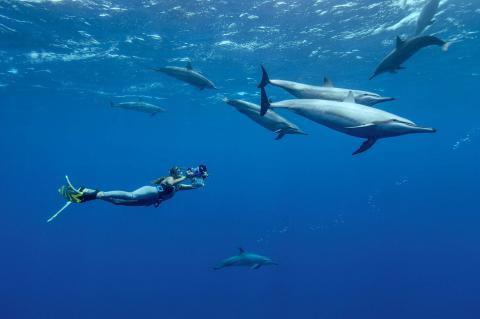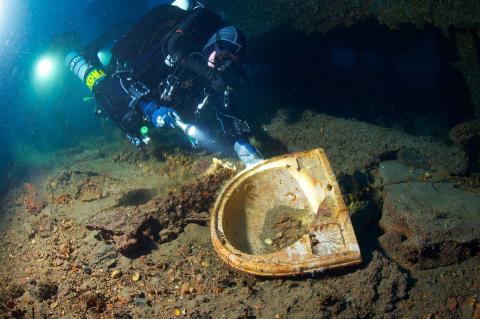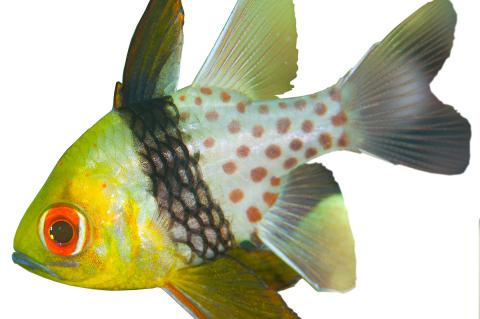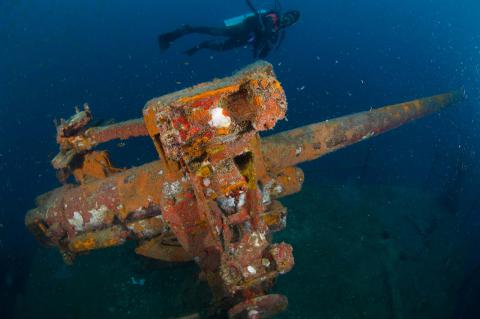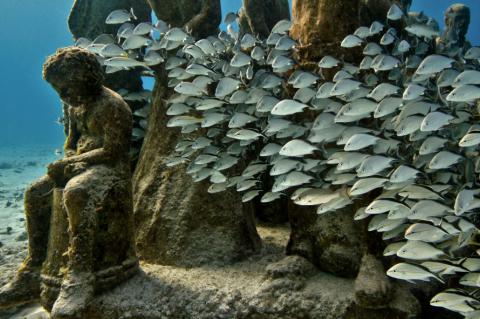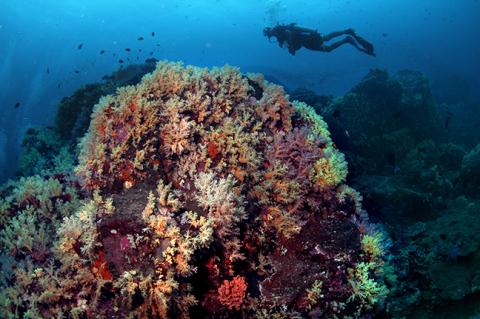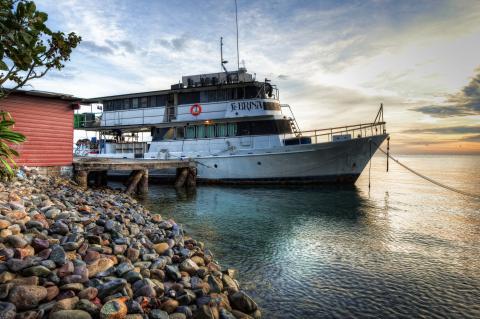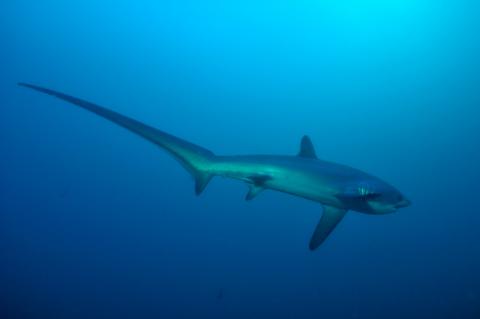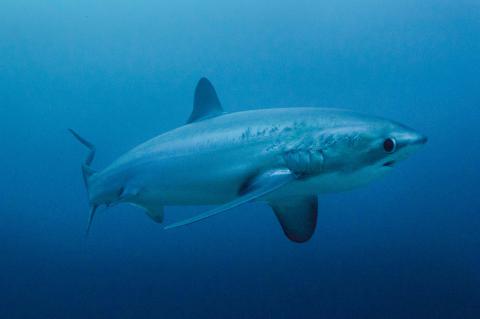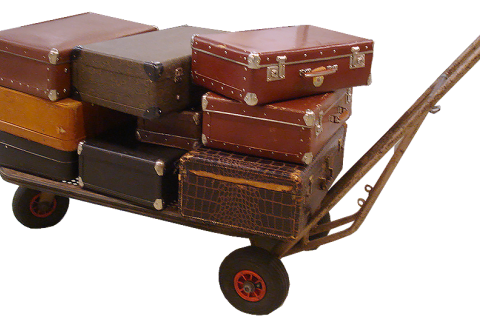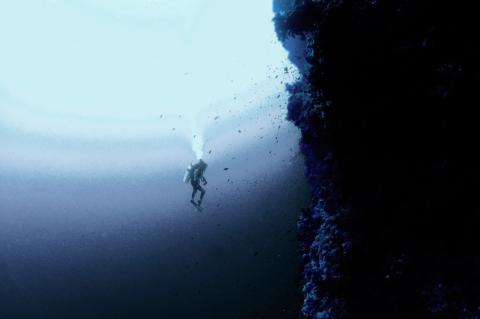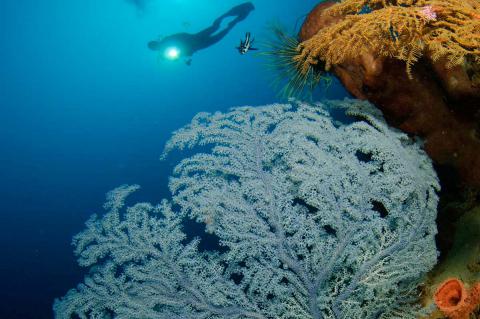X-Ray Mag #62
Diving Thailand's Similan Islands at Khao Lak; Papua New Guinea's Kimbe Bay; Malapascua Island's Thresher Sharks in the Philippines; The Coral Triangle's Biodiversity; Spain's España Wreck; HTMS Sattakut Wreck at Koh Tao Island; Just Culture; Scuba Confidential; Diving Solo; Freediving for Underwater Photographers; Evie Dudas profile; Interview with artist Jason deCaires Taylor; Plus news and discoveries, equipment and training news, books and media, underwater photo and video equipment, shark tales, whale tales and much more...
Main features in this issue include:
Apnea Pix
Taking pictures while freediving can be a real physical challenge, but in some cases, it may be the only option to get the subject in front of your lens.
Freediving in order to take underwater photographs is not the norm, but there are many freedivers who do just that—for example, the freediving icon Fred Buyle.
It is also a good technique to use for practical reasons; Without noisy bubbles, it becomes possible to get closer to shy creatures.
Battleship España
The battleship España has a very important place in the history of the Basque Country of northern Spain and is now a protected monument at the bottom of the sea.
In August 1915, the battleship was originally christened the Alphonso XIII after the current king of Spain, in the shipyard of Vickers-Ferrol and had two sister ships named España and Jaime I.
Biodiversity on Wakatobi Reef
Coral reefs are places of immense natural diversity. They accommodate some of the highest densities of animals on earth and have more species than any other marine habitat. However, the species inhabiting coral reefs are not distributed evenly through the oceans.
Richness differs dramatically between regions due to the many different pressures that have molded each community over millions of years. The world’s highest marine biodiversity is found in an area that has become known by conservationists as the ‘Coral Triangle’.
HTMS Sattakut
On a cold day in February 1944, little would the workers of the Commercial Iron Works in Portland, Oregon, have known of the fate and unlikely resting place of the USS LCI(L) 739—now known to those who visit her as the HTMS Sattakut.
After seeing out her years in both the U.S. and Thai navies, The HTMS Sattakut has now found her final resting place in the Gulf of Thailand just off a little island called Koh Tao.
Jason deCaires Taylor
British artist Jason deCaires Taylor has created unique underwater sculptures and installations in locations all over the world. We first interviewed him in 2007 when he finished a photo-documentary of one of his earliest works in Grenada.
"We inhabit this is incredibly beautiful planet and are slowly ruining it, but we still have an opportunity to safeguard its future, and that’s the message that I try to convey."
-- Jason deCaires Taylor
Just Culture
A diver had an oxygen toxicity seizure because an incorrect gas was filled in a cylinder by a dive centre. A baby died because the wrong dose of medication was injected. Who is to blame for the error and how do we try to make sure that these types of incidents aren’t repeated?
Some of the readers may remember an article I wrote on this subject a couple of years ago, but this one will go into much more depth and give examples of the issues faced in both the scuba diving community and other environments, which have more established safety management system programmes and
Khao Lak
My dive buddy, Kate, is trying to get a shot of a purple sea fan but she’s having trouble with her strobes and my ADD is kicking in. This happens occasionally. I try to be a good buddy, I really do, but there’s just so damn much to see underwater and I get antsy if we stop too long for a photograph.
This is the conversation I’m having with myself when I feel something tickle the back of my neck. It’s not physical—it’s more like a soft breath against my brain, a whispering ghost of premonition. I look up and my eyes widen as my heart begins to pound involuntarily.
Kimbe Bay
There is a line of thought in the scientific community that this is where it all began and the first corals originated… a large sheltered bay, roughly one third along the north coast of the island now called New Britain.
There can be no doubt regarding the profound fecundity of Kimbe Bay because the numbers, as they say, cannot lie and surveys by some of the best known names in marine biology, such as Professor Charles Veron and Dr Jerry Allen, and respected organizations like The Nature Conservancy, have helped
Malapascua Island's Thresher Shark Experience
The fox shark, also called the common thresher shark, lives usually at depths of over 200 meters and it is sighted only rarely. This is the main reason, we don’t know very much about these animals, and there is very little good visual documentation showing thresher sharks up close on camera.
Attracted by several cleaning stations, the sharks come regularly before sunset for their early morning “toilette”. They are cleaned by the small cleaner wrasse that clean the sharks' skin, gills and even inside their mouths of parasites, bacteria and food debris.
Malapascua Island: Where thresher sharks roam
As picture perfect as Malapascua is, in a nation of 7,107 palm tree fringed islands, 2.5km long Malapascua wouldn’t be on anyone’s radar were it not for the thresher sharks that treat the island like a spa. Each morning as the sun peeks over the mountains on distant Cebu, Pelagic threshers rise from the depths to be cleaned by reef fish along a deep ledge known as Monad Shoal.
When my plane touched down in Cebu City in the central Philippines, the ground had barely stopped shaking from a catastrophic earthquake that rocked Bohol and Cebu causing severe property damage and loss of life.
Preparing Yourself for Dive Travel
“By failing to prepare, you are preparing to fail.” — Benjamin Franklin
Preparation must begin long before you arrive at your chosen dive site and involves a number of components. These components include the trip as well as the diving. We will focus first on preparing for the trip to your dive location.
Profile Evie Dudas
As Evelyn Bartram Dudas’s Nikonos III made its way toward the bottom of the Atlantic Ocean one day not too long ago, she did the only thing that made sense to her at the time. She dove after it, retrieving the camera just before it was lost amidst the twisted remains of a shipwreck on the sea floor. Her rapid descent cost her a broken eardrum.
The following is an article entitled “Sea Fever” previously published in AquaCorps Magazine, No. 1 February-March 1990.
Solo Divers and Risk Management
Diving is risky business. Just how risky depends on a whole shopping list of factors and influences, but let’s agree that there are more risks involved with diving than, say, sitting in your basement watching Olympic curling on TV.
What if diving was new?
Imagine scuba diving is a brand new sport. You hear about it for the first time when one of your friends tells you about a scuba experience she had recently on holiday and you think this sounds incredibly exciting. After thinking about it for a long time, you decide you want to learn. You take lessons to improve your swimming and then you look online for a dive instructor. There are no dive centres in your town.
You are the first person you know who has signed up for a scuba diving course. For the people of your parents’ generation, even if they were aware that scuba diving existed, they would never have considered it even remotely possible that they could learn to dive.


